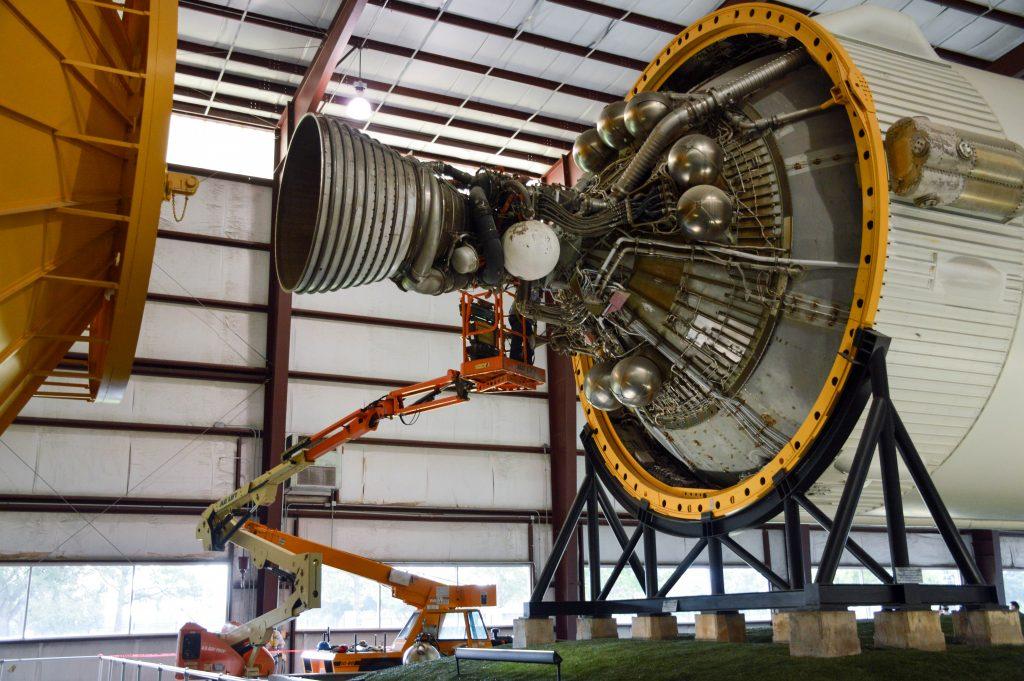By Jubenal Aguilar
Managing Editor

A retired Saturn V Rocket on permanent display at Rocket Park in NASA’s Johnson Space Center in Houston.
NASA is making advancements in preparing its first manned mission to Mars.
Four NASA representatives discussed the mission challenges during a press conference Oct. 14 at NASA’s Johnson Space Center in Houston.
Haley Fick, a NASA public affairs specialist, said the space agency has been preparing for the mission for decades using the accumulated experiences of past missions.
The Mars mission consists of three phases – Earth reliant zone, proving ground and Mars ready. Fick said each phase is designed to expand on the mission preparation objectives so NASA can eventually land a human on the red planet.
Michelle Rucker, a NASA engineer for 30 years, said the agency’s teams faced many challenges in preparing for the mission, including getting large vehicles to the planet. Rucker said multiple landers will need to be sent for the astronaut team.
Rucker said other problems include the distance from Earth to Mars and the length of time for the mission. Astronauts will need to adjust to the effects of extended exposure to reduced gravity during the approximately six-month-long trip. Upon arrival, the teams will need to set up a station on their own.
The typical space mission, Fick said, is also about six months long. This has given the agency an opportunity to study the effects of microgravity on humans.
A third problem is slow communication with the red planet, Rucker said.
Elizabeth Rampe, a Mars research scientist who holds a doctorate in geological science, said slow communication is the reason Mars rovers have only traveled about 10 miles since 2012.
Rampe said a manned mission could also help with exploring the planet faster because the astronauts will be able to make decisions based on their surroundings without relying on JSC to receive and send instructions as it does with the rovers.
Because of the length of the mission, Rucker said, astronauts on the mission will need to make the rocket propellant for their return trip.
The last challenge will be avoiding environmental contamination of the planet, Rucker said.
Rucker and Rampe said the mission’s success will depend on utilizing the resources found on the red planet.
If water is found on the surface, Rucker said, a lot can be done to improve the chances of success.
“We can crack the water and separate the oxygen,” Rucker said. “So now [the astronauts] can have breathing oxygen as well.”
The red color of the planet is due to the rich presence of iron in the soil, Rucker said. Perchlorates in the soil can also be used for energy.
An advantage for the mission, Rampe said, includes the ability of astronauts to quickly learn other disciplines they may need to be successful. Astronauts from previous missions had to learn about other subjects they have had no prior experience with. The astronauts for this mission will need to learn about geology to be able to successfully explore and categorize the surface of the planet.
Part of the mission includes making decisions on where to land and explore, Rampe said.
“We think Mars was much more earthlike in its distant past,” Rampe said.
Geological- and weather-related evidence can be found all over the surface of the planet, indicating there was once running water on the surface. Rampe said the mission goals include finding out what happened to this water.
“The ultimate question that we want to know is, ‘Was there ever life on Mars?’” Rampe said. The presence of water on the surface is an indication that life may have once existed on Mars.
“Life as we know it on Earth requires liquid water,” Rampe said.
Joe Caram, chief of JSC’s Exploration Mission Planning Office, said the agency is preparing for the mission by joining forces with other space agencies and companies. NASA has worked with Lockheed Martin, the Sierra Nevada Corps and Space X to assist on missions and create a synergy that will benefit all of the agencies.
Caram said the next step after exploration of Mars will be to explore deep space habitation and to develop the capability to take humans farther into space. “Congress and the president have been very supportive of that strategy,” he said.






